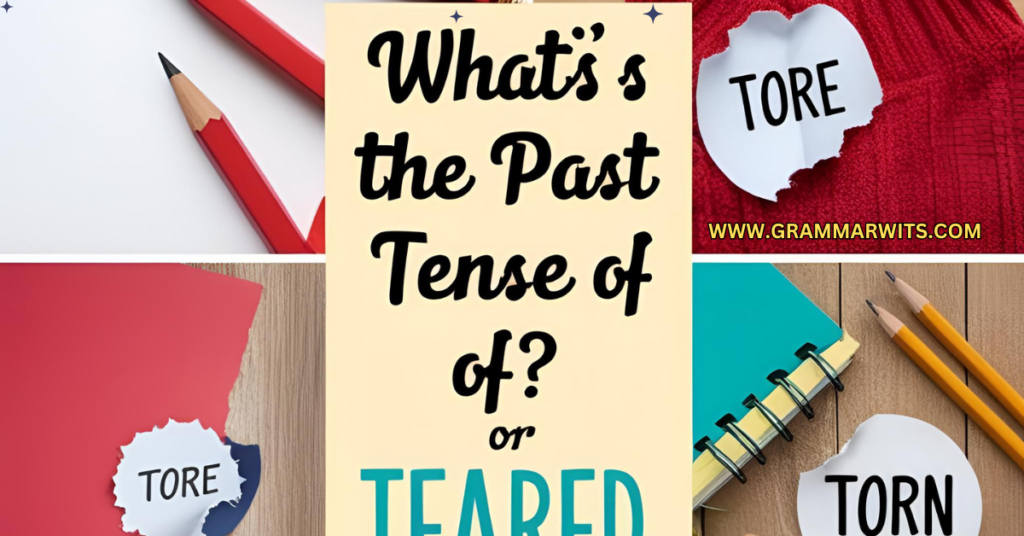The verb “tear” refers to the action of ripping or causing something to split, usually through force. It can also be used in the context of shedding tears, often associated with emotional responses. When it comes to the past tense, English speakers often encounter the confusion between “tore,” “teared,” and “torn.” These variations create common misunderstandings, even though they all describe an action completed in the past. It’s easy to mix up the past tense of tear tore teared or torn without proper examples.
Imagine you’re reading your favorite book, and suddenly a page rips or a person’s eyes well up with tears—what tense would you use? The beauty of the English language is how small changes in word form can completely alter the meaning of a sentence. Understanding the differences between “tear,” “tore,” “teared,” and “torn” can transform your writing from basic to sophisticated, ensuring that you express yourself precisely. A common English mistake is misusing the past tense of tear tore teared or torn in writing.
The past tense of “tear” can be tricky, as it’s commonly misused. “Tore” is the correct past tense when referring to an action of ripping or splitting, while “torn” is the past participle form. “Teared,” though sometimes used, is less common and considered incorrect in standard grammar. Knowing how to use these forms correctly enhances clarity in both written and spoken English, making your communication more effective and accurate.
Two Different Words, Same Spelling
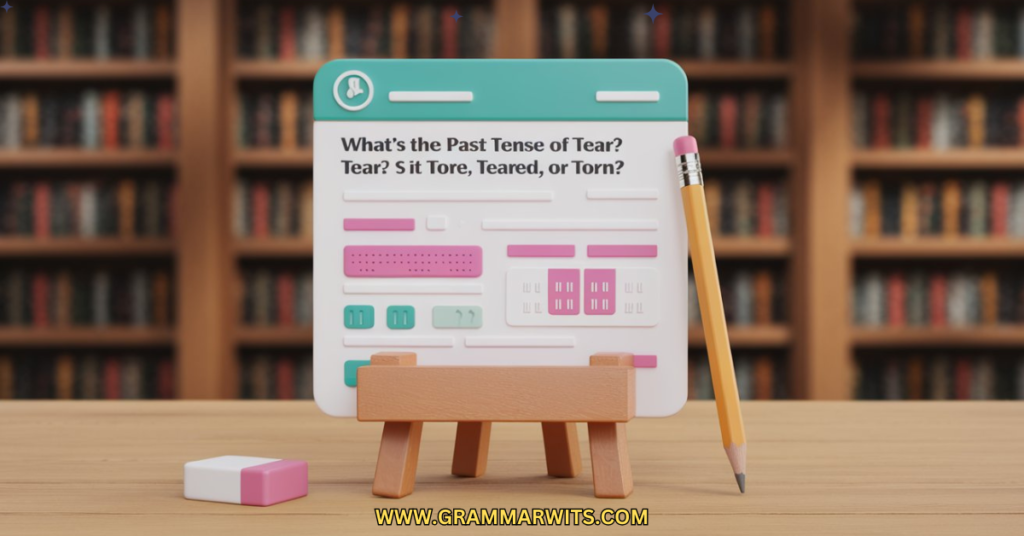
The English language loves to keep us on our toes, and the word “tear” is a perfect example. This seemingly simple four-letter word actually represents two entirely different concepts:
- Tear (pronounced “tare”) – to rip or pull apart something
- Tear (pronounced “teer”) – the droplet produced when crying or shedding tears
This distinction is crucial because these homographs (words spelled the same but with different meanings) follow different conjugation patterns. The confusion stems from the fact that one follows an irregular pattern while the other follows regular verb conjugation rules. While reading old books, I noticed different uses of the past tense of tear tore teared or torn.
Let’s dive deeper into why these words cause such language confusion and how to master their correct usage.
The Complete Conjugation of “Tear” (to rip)
When we talk about tearing paper, fabric, or any material, we’re using “tear” as an irregular verb (pronounced “tare”). Here’s how it conjugates:
Present Tense Forms
- I/you/we/they tear (base form)
- He/she/it tears (third-person singular)
- I am/you are/he is tearing (present participle)
Past Tense Forms
- I/you/he/she/it/we/they tore (simple past tense)
Past Participle
- I/you/he/she/it/we/they have/has torn (perfect tenses)
Let’s see these forms in action:
“I tear the page from my notebook every day.” (present simple)
“She tears apart every letter she receives from him.” (present simple, third person)
“They were tearing the old wallpaper off the walls.” (past continuous)
“Yesterday, I tore my favorite jeans.” (simple past tense)
“He has torn the contract into pieces.” (present perfect)
The key here is understanding that the past tense of tear (to rip) is “tore,” and its past participle is “torn.” These forms might seem arbitrary, but they follow patterns similar to other irregular verbs like “wear/wore/worn” and “bear/bore/born.”
The Complete Conjugation of “Tear” (to cry)

Now let’s look at the other “tear”—the one that falls from your eyes when you’re sad, cutting onions, or experiencing strong emotions. This version of “tear” (pronounced “teer”) follows regular conjugation patterns:
Present Tense Forms
- I/you/we/they tear (base form)
- He/she/it tears (third-person singular)
- I am/you are/he is tearing up (present participle)
Past Tense Forms
- I/you/he/she/it/we/they teared up (simple past tense)
Past Participle
- I/you/he/she/it/we/they have/has teared up (perfect tenses)
Let’s see these forms in examples:
“I often tear up during emotional movies.” (present simple)
“He tears up whenever he hears that song.” (present simple, third person)
“She was tearing up as she read the letter.” (past continuous)
“They teared up during the graduation ceremony.” (simple past tense)
“I have teared up three times today.” (present perfect)
It’s important to note that this version of “tear” is almost always used with “up” as a phrasal verb when referring to emotional expression or weeping. When someone “tears up,” they’re beginning to cry or showing signs of emotional crying. Understanding the past tense of tear tore teared or torn helps improve both speaking and writing.
Comprehensive Verb Tables
To make this even clearer, let’s compare both versions of “tear” side by side:
Table 1: Conjugation of Both Forms of “Tear”
| Tense | Tear (to rip) | Tear (to cry) |
|---|---|---|
| Present Simple | tear/tears | tear/tears |
| Present Continuous | tearing | tearing (up) |
| Past Simple | tore | teared (up) |
| Past Continuous | was/were tearing | was/were tearing (up) |
| Present Perfect | have/has torn | have/has teared (up) |
| Past Perfect | had torn | had teared (up) |
| Future Simple | will tear | will tear (up) |
| Future Perfect | will have torn | will have teared (up) |
Table 2: Pronunciation Guide
| Word Form | Pronunciation | Example |
|---|---|---|
| tear (to rip) | tare (rhymes with “care”) | “Be careful not to tear the paper.” |
| tear (crying) | teer (rhymes with “fear”) | “A tear rolled down her cheek.” |
| tore | tor (rhymes with “for”) | “He tore the envelope open.” |
| torn | torn (rhymes with “born”) | “The flag was torn in the storm.” |
| teared | teerd (rhymes with “feared”) | “She teared up at the news.” |
In-Context Examples
Let’s explore how these different forms of “tear” are used in various contexts:
Literary Examples of “Tore” and “Torn”
“He tore a page from his notebook and handed it to me.” – F. Scott Fitzgerald, The Great Gatsby
“The sails were torn to tatters in the gale.” – Herman Melville, Moby-Dick
“She tore through the manuscript, making notes in the margins.” – Stephen King, On Writing
Common Phrases and Idioms
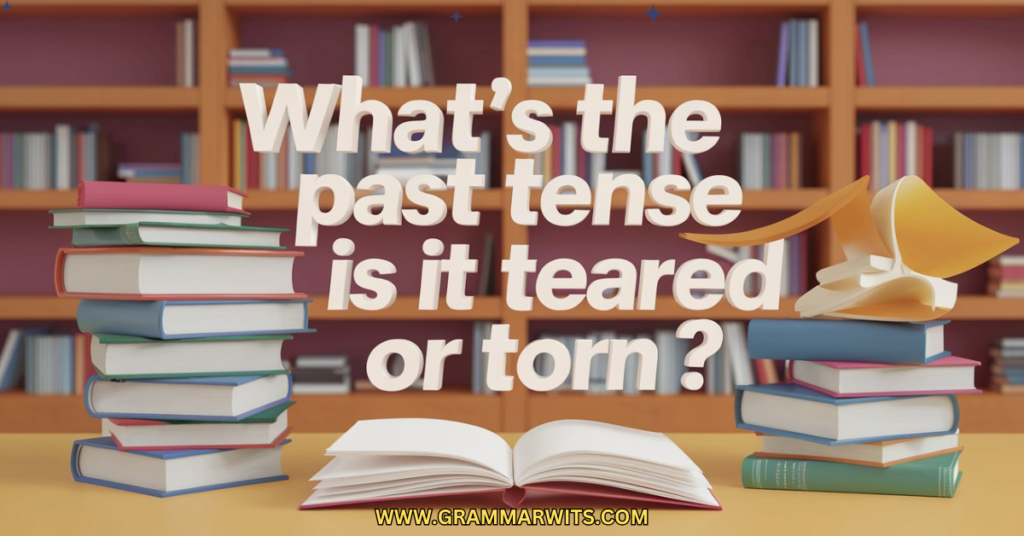
- Torn between two choices (feeling conflicted)
- Tear apart (to criticize severely)
- Tore into (to attack verbally or physically)
- Tear down (to demolish or criticize)
- Tear up (to destroy or to begin crying)
- Tear-stained cheeks (marked by tears from crying)
- Tear-jerking (emotionally moving, causing tears)
Examples Showing Where “Teared” Is Appropriate
“The audience teared up during the emotional scene.”
“She teared up as she accepted the award.”
“His eyes teared when exposed to the tear gas.”
Notice how “teared” is almost exclusively used in the context of crying or having eyes fill with fluid tears, and it’s often paired with “up” to form the phrasal verb “teared up.” Students often ask about the past tense of tear tore teared or torn, especially when writing stories.
Transitive vs. Intransitive Usage

Another important distinction lies in how these verbs function grammatically:
“Tear” (to rip) as a Transitive Verb:
When tearing something physically, we use it as a transitive verb that requires an object:
- “She tore the letter.” (The letter is being torn)
- “They have torn the contract.” (The contract is being torn)
“Tear” (to cry) as an Intransitive Verb:
When talking about crying, “tear” typically functions as an intransitive verb that doesn’t take a direct object:
- “He teared up during the speech.” (Nothing is being torn; he is producing tears)
- “Her eyes teared from the smoke.” (Her eyes are producing tears)
This grammatical difference further helps distinguish between the two uses of the word.
Etymology and Historical Development
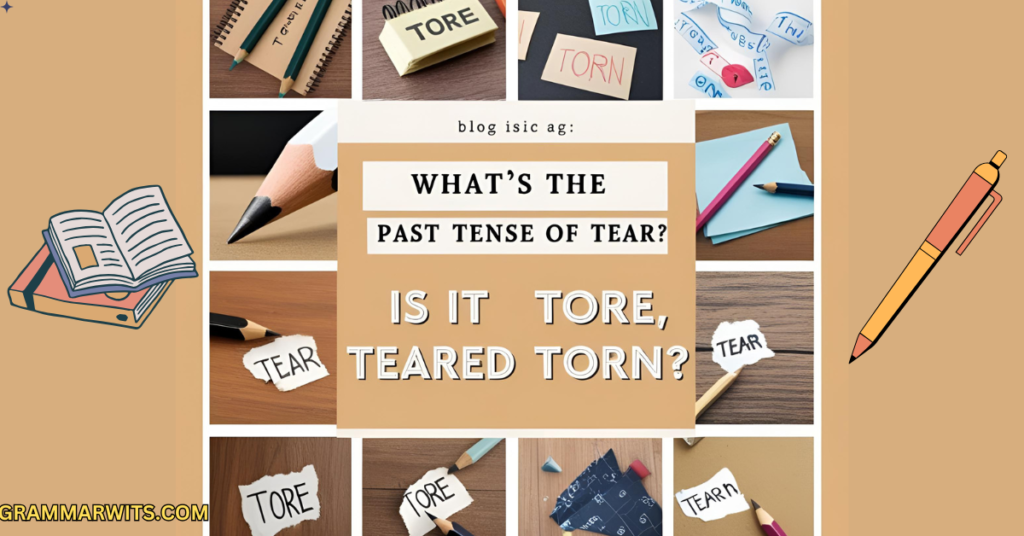
The fascinating thing about these two meanings of “tear” is that they have completely separate etymological origins:
Origins of “Tear” (to rip)
The verb “tear” (to rip) comes from the Old English word “teran,” which is related to the Old High German “zeran” meaning to destroy. This verb has ancient Indo-European roots, connecting it to words that mean split, break, or lacerate. The grammar guide had a whole section on the past tense of tear tore teared or torn.
Its irregular conjugation (tear/tore/torn) has remained relatively stable throughout the development of English. Many of our most common verbs maintain these irregular patterns because they were among the most frequently used words in early English.
Origins of “Tear” (crying)
Interestingly, the noun “tear” (the droplet) comes from Old English “tēar” or “tæhher,” which is related to the Old Norse “tár” and Gothic “tagr.” The verb form—to produce tears—developed later as a derivative of the noun.
This explains why one form follows regular conjugation patterns (tear/teared/teared) while the other maintains an irregular pattern (tear/tore/torn). They’re essentially different words that happen to be spelled the same in modern English! Even advanced learners sometimes struggle with the past tense of tear tore teared or torn.
Common Mistakes and Corrections
Let’s examine some common errors people make with these tricky words:
Incorrect vs. Correct Usage
❌ “He teared the paper in half.” (Incorrect)
✅ “He tore the paper in half.” (Correct)
❌ “She has tore her dress.” (Incorrect)
✅ “She has torn her dress.” (Correct)
❌ “His eyes tore up when he heard the news.” (Incorrect)
✅ “His eyes teared up when he heard the news.” (Correct)
❌ “The fabric was teared during manufacturing.” (Incorrect)
✅ “The fabric was torn during manufacturing.” (Correct)
Why These Mistakes Happen
These errors typically occur because:
- People confuse the two different words “tear”
- They overgeneralize regular verb patterns
- They’re unfamiliar with irregular verb conjugations
- They’ve heard incorrect usage in casual speech
By understanding the distinct origins and conjugation patterns of these two words, you can avoid these common pitfalls.
Related Words and Phrases
Synonyms for Different Meanings of “Tear”
For “tear” (to rip):
- Ripping
- Shred
- Split
- Break
- Rend
- Rupture
- Sever
- Lacerate
For “tear” (to cry):
- Weep
- Sob
- Cry
- Shedding tears
- Whimper
- Wail
- Blubber
Phrasal Verbs with “Tear”
- Tear up (two meanings):
- To destroy by tearing: “He tore up the contract.”
- To begin crying: “She tore up when she heard the song.”
- Tear down:
- To demolish: “They tore down the old building.”
- To criticize harshly: “The critic tore down her performance.”
- Tear into:
- To attack verbally: “The boss tore into him for being late.”
- To begin eating eagerly: “He tore into the meal after fasting.”
- Tear away:
- To remove forcefully: “She tore away the wrapping paper.”
- To separate reluctantly: “He tore himself away from the TV.”
Memory Tricks and Learning Aids
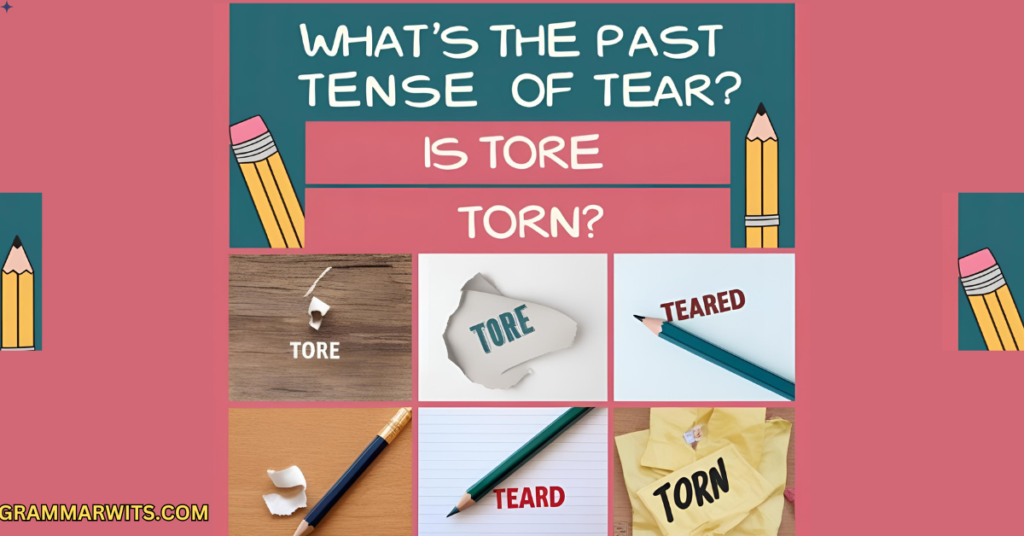
Struggling to remember which form to use? Try these helpful techniques:
Mnemonic Device for “Tear/Tore/Torn”
Think: “I tore my pants, now they’re torn.” This reminds you that “tore” is the simple past and “torn” is the past participle for the ripping meaning.
Pattern Recognition
Notice how “tear/tore/torn” follows the same pattern as:
- wear/wore/worn
- bear/bore/born(e)
- swear/swore/sworn
If you know these verbs, you can apply the same pattern to “tear.”
Visual Association
For “tear” (crying): Picture a tear drop shaped like the letter “D” to remind you it uses the regular “-ed” ending: “teared.”
For “tear” (ripping): Imagine the word being ripped into “tore” and then further ripped into “torn.”
Case Study: Language Learner’s Journey
Maria’s English Learning Challenge
Maria, an advanced English learner from Spain, consistently struggled with the past tense forms of “tear.” In her native language, there was no such distinction between homographs with different conjugations. Learning the correct past tense of tear tore teared or torn can boost your English confidence.
During a writing assignment, she wrote: “The boy teared the newspaper and then teared up because he felt bad about it.” Her English teacher marked this as incorrect and explained the distinction.
To help Maria remember, her teacher created this simple rule:
- If you can substitute the word “rip,” use “tore/torn”
- If you can substitute the word “cry,” use “teared up”
After practicing with this rule for several weeks, Maria mastered the distinction and never made the mistake again. She found that understanding the etymological difference helped her conceptualize these as truly different words that happened to be spelled the same.
Quick Reference Guide
Here’s a cheat sheet for writers and editors to quickly reference when working with the word “tear”:
“Tore”:
- Simple past tense of tear (to rip)
- “Yesterday, she tore her dress.”
“Torn”:
- Past participle of tear (to rip)
- Used with helping verbs (has, have, had, was, were)
- “The paper has been torn.”
- “His jeans were torn at the knee.”
“Teared”:
- Past form of tear (to produce tears from eyes)
- Almost always used with “up”
- “She teared up at the wedding.”
- “His eyes teared from the smoke.”
Exploring the Nuances: Tear as a Noun
While we’ve focused on the verb forms, it’s worth exploring the noun forms as well, as they relate to our understanding of the verb conjugations:
The Noun “Tear” (The Fluid Drop from the Eye)
When we talk about a tear as the droplet produced during crying, we pronounce it as “teer.” This noun form relates directly to the verb “to tear up” (to cry).
Examples:
- “A single tear rolled down her cheek.”
- “He wiped away the tears of joy.”
Related terms:
- Tear ducts: The structures that produce tears
- Tear gas: Irritant that causes excessive tearing
- Tear-stained: Marked by dried tears
The Noun “Tear” (A Ripping or Laceration)
We can also use “tear” (pronounced “tare”) as a noun to describe the result of tearing something:
Examples:
- “There was a tear in the fabric of her dress.”
- “The mechanic found a tear in the fuel line.”
This noun form directly relates to the verb “to tear” (to rip).
The Linguistic Phenomenon Explained
The confusion around the past tense of tear exemplifies several interesting aspects of English verb forms and language rules:
Homographs and Their Challenges
Homographs—words spelled the same but with different meanings and often different pronunciations—create natural confusion points in language. The word “tear” is a perfect example of how homographs can follow completely different grammatical rules despite identical spelling.
Regular vs. Irregular Verbs
English has about 200 irregular verbs, many of which are among the most commonly used verbs in the language. “Tear” (to rip) is one such irregular verb, while “tear” (to cry) follows the regular pattern of adding “-ed” for past forms.
Phrasal Verbs and Context
Context often helps differentiate between these forms. The crying version of “tear” typically appears with “up” (as in “teared up”), while the ripping version stands alone or combines with other particles like “down,” “apart,” or “away.”
Figurative Uses and Expressions
Both forms of “tear” have developed rich figurative meanings beyond their literal uses:
Figurative Uses of “Tear” (to rip)
- “The scandal tore apart the community.” (divided)
- “The news tore through the office.” (violent movement)
- “She tore down his arguments one by one.” (dismantled)
- “The runner tore ahead of the competition.” (moved rapidly)
Figurative Uses of “Tear” (to cry)
- “The movie is a real tear-jerker.” (causes emotional crying)
- “His story brought tears to my eyes.” (evoked emotion)
- “She fought back tears during the speech.” (controlled emotion)
These metaphorical extensions show how deeply these words are embedded in our expressions of both physical and emotional experiences.
Practical Applications for Writers and Speakers
Understanding the correct usage of “tear” in its various forms has practical benefits:
For Creative Writers
Using the correct forms adds precision and clarity to your descriptions. Compare:
- “He teared the letter” (incorrect, suggests crying on the letter)
- “He tore the letter” (correct, clearly indicates ripping)
For Professional Communication
In business writing, legal documents, or technical manuals, precision is crucial:
- “The contract was torn prior to submission” (clearly indicates physical damage)
- “The witness teared up during testimony” (indicates emotional response)
For English Learners
Mastering these distinctions marks an advanced understanding of English and helps avoid misunderstandings in both written and spoken communication.
Here are three additional topics you could add to the article about the past tense of “tear,” each with a 5-6 line paragraph:
Regional Variations in Usage
While the core rules for the past tense of “tear” remain consistent across English-speaking countries, subtle regional preferences exist in how these forms appear in everyday speech. American English speakers tend to use “teared up” more frequently in casual conversation, while British English speakers might favor phrases like “became tearful” or “welled up with tears.” Australian and Canadian usage largely aligns with their British and American counterparts, respectively. These regional preferences don’t change the fundamental rules we’ve discussed, but they do reflect how language evolves differently across geographical boundaries and cultural contexts.
Teaching “Tear” to Young Language Learners
Introducing the dual nature of “tear” to young language learners requires careful pedagogical approaches that acknowledge developmental stages. Teachers often find success using visual aids that distinguish between “tearing paper” (showing ripping motions) and “tearing up” (showing crying faces), creating a tangible connection between the action and the correct verb form. Hands-on activities where children physically tear paper while saying “I tear, I tore, I have torn” reinforce the irregular pattern, while emotion-based exercises help them practice the regular “teared up” form. This multisensory approach proves particularly effective for helping children internalize the distinction between these homographs before they encounter them in reading and writing.
Digital Communication and the Past Tense of “Tear”
The evolution of digital communication has influenced how we express emotions related to “tearing up” or things being “torn.” In text messages, social media, and online forums, people increasingly use emojis like 😢 or 😭 to replace written descriptions of tearing up, while torn objects might be represented by the 💔 emoji. Autocorrect and predictive text technologies sometimes struggle with the contextual differentiation between “tore” and “teared,” occasionally suggesting incorrect forms based on frequency rather than correct usage. This digital dimension adds another layer to how we navigate the past tense of “tear” in modern communication, where written language increasingly blends with visual symbols and faces greater technological mediation.
FAQ Section
Here are answers to some frequently asked questions about the past tense of tear:
Q: Can “teared” ever be used for ripping something?
A: No, “teared” should never be used to describe ripping or tearing something physically. The correct past tense for that meaning is “tore.”
Q: Why do we say “tear-stained” but not “tore-stained”?
A: “Tear-stained” refers to stains left by teardrops (the noun “tear” pronounced “teer”), not the action of ripping. It describes something marked by crying tears.
Q: Is it “tear-jerking” or “tore-jerking”?
A: It’s “tear-jerking” because it refers to something that makes you cry tears (produces the noun “tear”), not something that physically rips or tears.
Q: How do I know which pronunciation to use when reading “tear” aloud?
A: Context is key. If the word relates to crying or eyes, pronounce it “teer.” If it relates to ripping or pulling apart, pronounce it “tare.”
Q: Are there any dialects where these rules differ?
A: The basic conjugation patterns (tear/tore/torn and tear/teared/teared) remain consistent across all major English dialects, including American, British, Australian, and Canadian English.
Conclusion: Mastering the Past Tense of Tear
The English language often presents challenges that can trip up even native speakers, and the past tense forms of “tear” represent one of these tricky areas. Remember:
- For ripping or pulling apart: the past tense is “tore” and the past participle is “torn“
- For crying or producing tears: both the past tense and past participle are “teared” (usually with “up”)
Despite their identical spelling in the present tense, these words have completely different etymological origins and follow different conjugation patterns—one irregular, one regular. By understanding this distinction, you can avoid common errors and use these words with confidence.
The next time you need to describe something being ripped in the past, remember: it was “tore,” not “teared.” And when someone started crying, they “teared up,” they didn’t “tore up.” Master these distinctions, and you’ll tear through (move quickly through) English grammar with greater ease!
“The English language is a magnificent tapestry, though it appears to have been put together by someone who bought their inspiration from a discount store.” – Bill Bryson
Whether you’re learning English, teaching it, or simply striving for precision in your communication, understanding the correct past tense forms of tear will help you express yourself more clearly and accurately.

Alizy Smith is a passionate language enthusiast and the admin of Grammar Wits. With a love for wordplay, grammar quirks, and witty expressions, she’s dedicated to making language learning fun and accessible. From grammar tips to pun-filled laughs, Alizy ensures every piece of content entertains while educating — turning tricky rules into easy, enjoyable reads.
